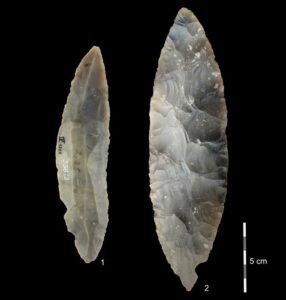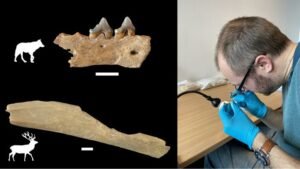A genetic analysis of bones found in Northern Europe shows that anatomically modern humans, aka Homo sapiens, first arrived in the area when it was already home to another enigmatic human species, Homo neanderthalensis.
Although advances in genetic analysis had already shown that early Europeans engaged and interbred with Neanderthals, the latest findings show that those first encounters took place during much earlier times before the extinction of this ancient offshoot of humanity.
Bone Fragments of Homo sapiens Dated From 47,500 to 45,000 Years Ago
Performed by researchers from the University of California, Berkeley, and supported by the Max Planck Society, the new analysis involved numerous bone fragments collected at the Ilsenhöhle cave site near Ranis, Germany. Previous excavations at the site had revealed finely-flaked, leaf-shaped stone tools, placing it among the oldest known sites of Stone Age human culture in north-central and northwestern Europe.
According to a press release announcing the findings, “the stone blades at Ranis, referred to as leaf points, are similar to stone tools found at several sites in Moravia, Poland, Germany, and the United Kingdom. These tools are thought to have been produced by the same culture referred to as the Lincombian–Ranisian–Jerzmanowician (LRJ) culture or technocomplex.”


Radiocarbon dating had placed the date of manufacture for the tools to at least 40,000 years ago, but until the most recent excavations, there had not been any bones to properly attribute who made them. In fact, the early manufacture date had caused many to propose that the tools had been made by Neanderthals and that modern-day humans had not yet arrived in the area. Both of those ideas have been proven false by these new findings.
“[These findings show that] Homo sapiens made this technology and that Homo sapiens were this far north at this time period, which is 45,000 years ago,” said Elena Zavala, one of four first authors of the Nature paper and a Miller Research Fellow at the University of California, Berkeley. “So these are among the earliest Homo sapiens in Europe.”
“The Ranis cave site provides evidence for the first dispersal of Homo sapiens across the higher latitudes of Europe. It turns out that stone artifacts that were thought to be produced by Neanderthals were, in fact, part of the early Homo sapiens toolkit,” said Jean-Jacque Hublin, a professor at the Collège de France in Paris and the former director of the Max Planck Institute for Evolutionary Anthropology where Zavala first began this work. “This fundamentally changes our previous knowledge about the period: Homo sapiens reached northwestern Europe long before Neanderthal disappearance in southwestern Europe.”
Data From Both Early and Modern Excavations ProvE Occupants were Homo sapiens
To perform their DNA analysis, which is published in the journal Nature, Zavala and Dr. Marcel Weiss, Friedrich Alexander University Erlangen-Nürnberg & MPI for Evolutionary Anthropology, Dr. Geoff Smith, University of Kent, Canterbury & MPI for Evolutionary Anthropology, and Dr. Sarah Pederzani, University of La Laguna & MPI for Evolutionary Anthropology, collected mitochondrial DNA (mtDNA) from bones excavated as far back as the 1930s and as recently as 2022. This included four fragments collected by Zavala’s team and nine fragments collected during the 1930’s expeditions.


This involved employing specialized techniques designed to isolate and sequence the highly fragmented DNA from the collection of bones. The results not only determined that the people who made the stone tools were Homo sapiens but also indicated that all 13 samples may have come from a family or maybe even one person.
“We confirmed that the skeletal fragments belonged to Homo sapiens,” Zavala explained. “Interestingly, several fragments shared the same mitochondrial DNA sequences — even fragments from different excavations.” The professor also said that shared mitochondrial DNA is the type of DNA that is passed down maternally, which likely indicates that the bones belonged to one individual or their maternal relatives.
“This [links] these new finds with the ones from decades ago,” said Zavala.


Ranis Cave Dwellers DNA Potentially Connected to 43,000-Year-Old Czech Skull
Another interesting result of the mtDNA analysis was the potential connection to DNA from a skull found in a cave at Zlatý kůň in the Czech Republic. Previous analysis dated that skull to around 43,000 years ago, making that individual as much as 4,000 years younger than the people living in Ranis.
“That raises some questions,” Zavala said. “Was this a single population? What could be the relationship here?”
The researcher also cautions that because mtDNA is only passed down through the mother, it provides only one side of that person’s history. “It’s only the maternal side,” she explained. “We would need to have nuclear DNA to be able to start looking into this.”
Results Fundamentally Change Ideas About Human Settlement of Northern Europe
Another first author, Helen Fewlass, a former Max Planck researcher who is now a European Molecular Biology Organization (EMBO) Postdoctoral Fellow at the Francis Crick Institute in London, says that their results support the idea that Homo sapiens were indeed in this part of the continent as early as 45,000 years ago and likely earlier.
“The evidence suggests that Homo sapiens were sporadically occupying the site from as early as 47,500 years ago,” said Fewlass.


Due to the comprehensive genetic analysis, isotopic testing, archaeological analysis, and radiocarbon dating done on the various bones and tools collected at the site, the results have been separated into three different papers. They are published in the journals Nature and Nature Ecology Evolution.
Finally, when noting the significance of the findings featured in those publications, Tim Schüler of the Thuringian State Office for the Preservation of Historical Monuments and Archaeology in Weimar, Germany, said, “The results from the Ilsenhöhle in Ranis fundamentally changed our ideas about the chronology and settlement history of Europe north of the Alps.”
Christopher Plain is a Science Fiction and Fantasy novelist and Head Science Writer at The Debrief. Follow and connect with him on X, learn about his books at plainfiction.com, or email him directly at christopher@thedebrief.org.

